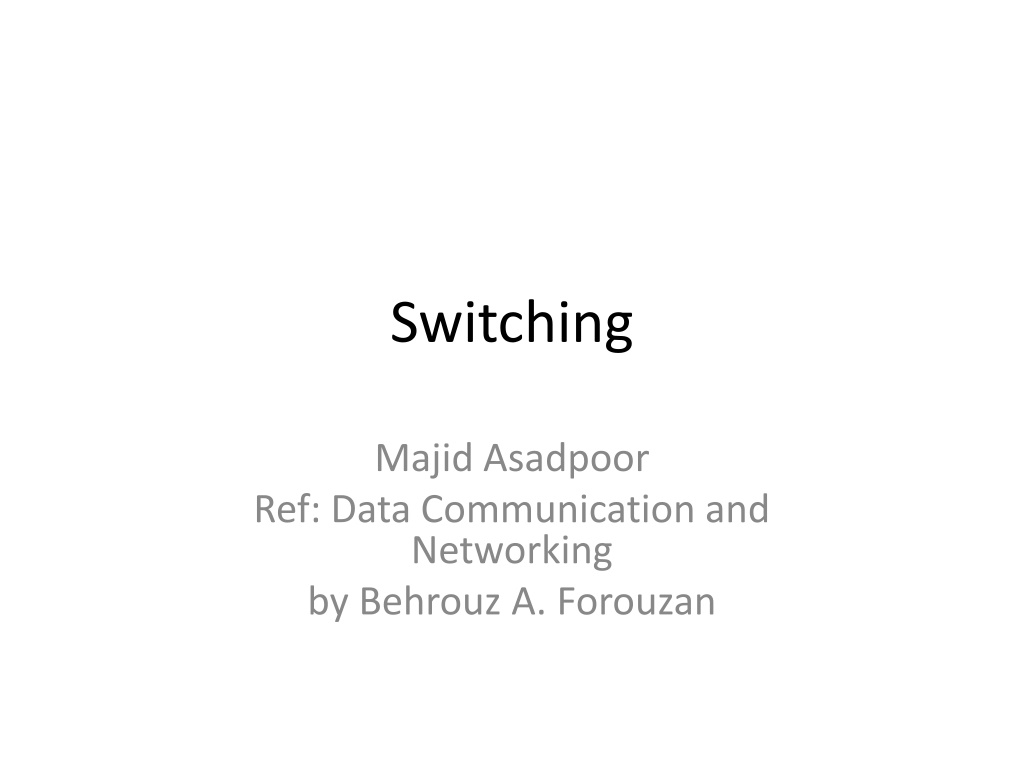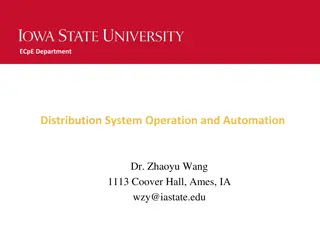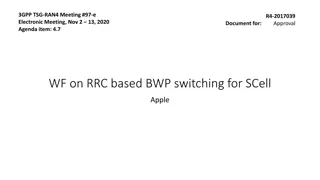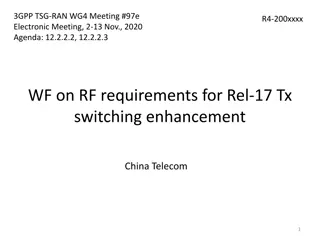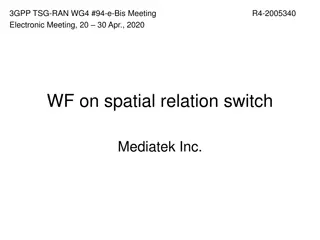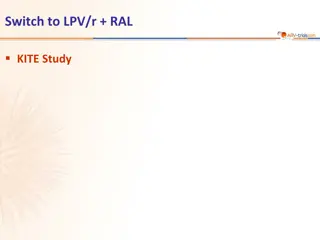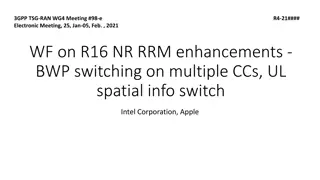Switching
Explore the essential concepts of data communication and networking through the expertise of Behrouz A. Forouzan. Delve into the intricacies of networking technologies, protocols, and principles to enhance your understanding of this vital field. This comprehensive resource is designed to provide a solid foundation in data communication, making it a valuable asset for students, professionals, and enthusiasts alike. Dive into the world of modern connectivity with this insightful guide and broaden your knowledge in the realm of data communication and networking.
Download Presentation

Please find below an Image/Link to download the presentation.
The content on the website is provided AS IS for your information and personal use only. It may not be sold, licensed, or shared on other websites without obtaining consent from the author.If you encounter any issues during the download, it is possible that the publisher has removed the file from their server.
You are allowed to download the files provided on this website for personal or commercial use, subject to the condition that they are used lawfully. All files are the property of their respective owners.
The content on the website is provided AS IS for your information and personal use only. It may not be sold, licensed, or shared on other websites without obtaining consent from the author.
E N D
Presentation Transcript
Switching Majid Asadpoor Ref: Data Communication and Networking by Behrouz A. Forouzan
Index Circuit Switching Packet switching (datagram switching) Packet switching (virtual-circuit switching) Structure of switch
Switching how to connect Whenever we have multiple devices? make a point-to-point connection between each pair of devices (a mesh topology) ? make a connection between a central device and every other device (a star topology)? impractical and wasteful when applied to very large networks. The number and length of the links require too much infrastructure to be cost-efficient the majority of those links would be idle most of the time. A better solution is switching. A switched network consists of a series of interlinked nodes, called switches creating temporary connections between two or more devices linked to the switch.
Switched Network The end systems (communicating devices) are labeled A, B, C, D, and so on, switches are labeled I, II, III, IV, and V
Switching Methods Today the tendency in packet switching is to combine datagram networks and virtualcircuit networks. Networks route the first packet based on the datagram addressing idea, but then create a virtual-circuit network for the rest of the packets coming from the same source and going to the same destination.
CIRCUIT-SWITCHED NETWORKS each connection uses only one dedicated channel on each link. Each link is normally divided into n channels by using FDM or TDM
CIRCUIT-SWITCHED NETWORKS Circuit switching takes place at the physical layer Before starting communication, make a reservation for the resources ( Setup Phase ) resources, such as channels (bandwidth in FDM and time slots in TDM), switch buffers, switch processing time, Data transferred between the two stations are not packetized (physical layer transfer of the signal). There is no addressing involved during data transfer. The switches route the data based on their occupied band (FDM) or time slot (TDM). there is end-to-end addressing used during the setup phase
CIRCUIT-SWITCHED NETWORKS Example 1 Telephone 1 is connected to telephone 7; 2 to 5; 3 to 8; and 4 to 6 The situation may change when new connections are made
CIRCUIT-SWITCHED NETWORKS Example 2
CIRCUIT-SWITCHED NETWORKS Setup Phase Before the two parties can communicate, a dedicated circuit needs to be established. connection setup means creating dedicated channels between the switches. end-to-end addressing is required for creating a connection between two end systems. These can be, for example, the addresses of the computers assigned by the administrator in a TDM network, or telephone numbers in an FDM network. Data Transfer Phase After the establishment of the dedicated circuit (channels), the two parties can transfer data Teardown Phase When one of the parties needs to disconnect, a signal is sent to each switch to release the resources
CIRCUIT-SWITCHED NETWORKS Efficiency are not as efficient as the other two types of networks because resources are allocated during the entire duration of the connection and are unavailable to other connections. Delay the delay in this type of network is minimal
CIRCUIT-SWITCHED NETWORKS Delay delay caused by the setup is the sum of four parts: the propagation time of the source computer request (slope of the first gray box), the request signal transfer time (height of the first gray box), the propagation time of the acknowledgment from the destination computer (slope of the second gray box), the signal transfer time of the acknowledgment (height of the second gray box). The delay due to data transfer is the sum of two parts: the propagation time (slope of the colored box) data transfer time (height of the colored box), which can be very long. The third box shows the time needed to tear down the circuit. We have shown the case in which the receiver requests disconnection, which creates the maximum delay.
Circuit-Switched Technology in Telephone Networks telephone companies usef circuit switched approach the telephone number is used as the global address signaling system (called SS7) is used for the setup and teardown phases.
DATAGRAM NETWORKS messages needs to be divided into packets of fixed or variable size there is no resource allocation for a packet and are allocated on demand The allocation is done on a firstcome, first-served basis each packet is treated independently of all others Packets in this approach are referred to as datagrams Datagram switching is normally done at the network layer
DATAGRAM NETWORKS may travel different paths to reach their destination out of order Transfer different delays between the Packets Packets may be lost or dropped In most protocols, it is the responsibility of an upper- layer protocol to reorder the datagrams or ask for lost datagrams before passing them on to the application. There are no setup or teardown phases (connectionless networks )
Routing Table If there are no setup or teardown phases, how are the packets routed to their destinations in a datagram network? each switch has a routing table which is based on the destination address The destination addresses and the corresponding forwarding output ports are recorded in the tables In table of a circuit switched network , each entry is created when the setup phase is completed and deleted when the teardown phase is over.
Routing Table Every packet in a datagram network carries destination address of the packet. the routing table is consulted to find the corresponding port through which the packet should be forwarded The address remains the same during the entire journey of the packet opposite in a virtual-circuit-switched network
Efficiency better than that of a circuit-switched network resources are allocated only when there are packets to be transferred
Delay May be greater delay in a datagram network than in a virtual-circuit network each packet may experience a wait at a switch before it is forwarded the delay is not uniform for the packets of a message
Delay three transmission times (3T), three propagation delays (slopes 3't of the lines), two waiting times (WI + w2) ignore the processing time in each switch. The total delay is Total delay =3T + 3t + WI + W2
Datagram Networks in the Internet Internet has chosen the datagram approach to switching at the network layer. uses the universal addresses defined in the network layer to route packets from the source to the destination
VIRTUAL-CIRCUIT NETWORKS is a cross between a circuit-switched network and a datagram network As in a circuit-switched network, there are setup and teardown phases Resources can be allocated during the setup phase, as in a circuit-switched network, or on demand, as in a datagram network. As in a datagram network, data are packetized each packet carries an address in the header. the address in the header has local jurisdiction. HOW? The answer will be clear when we discuss virtual-circuit identifiers in the next section. all packets follow the same path established during the connection. A virtual-circuit network is normally implemented in the data link layer circuit-switched network is implemented in the physical layer and a datagram network in the network layer. But this may change in the future.
VIRTUAL-CIRCUIT NETWORKS Addressing global Addressing Local Addressing Global Addressing A source or a destination needs to have a global address that can be unique and is used only to create a virtual-circuit identifier Virtual-Circuit Identifier The identifier that is actually used for data (VCI) VCI does not need to be a large since each switch can use its own unique set of VCls
Three Phases Setup phase the source and destination use their global addresses to help switches make table entries for the connection data transfer phase We discuss first in the next section Teardown phase the source and destination inform the switches to delete the corresponding entry
Data Transfer Phase switch holds four pieces of information for each virtual circuit that is already set up
Setup Phase setup request a) Source A sends a setup frame to switch 1. b) Switch 1 receives the setup request frame. It knows that a frame going from A to B goes out through port 3. How? The switch, in the setup phase, acts as a packet switch so through routing table .The switch creates an entry in its table for this virtual circuit, but fill three of the four columns. The switch assigns the incoming port (1) and chooses an available incoming VCI (14) and the outgoing port (3). It does not yet know the outgoing VCI, which will be found during the acknowledgment step. The switch then forwards the frame through port 3 to switch 2. c) Switch 2 receives the setup request frame. The same events happen here as at switch 1; d) e) Destination B receives the setup frame, and if it is ready to receive frames from A, it assigns a VCI to the incoming frames that come from A, in this case 77. This VCI lets the destination know that the frames come from A, and not other sources acknowledgment
Setup Phase/Acknowledge A. The destination sends an acknowledgment to switch 3. The acknowledgment carries the global source and destination addresses. The frame also carries VCI 77, chosen by the destination as the incoming VCI for frames from A. Switch 3 uses this VCI to complete the outgoing VCI column for this entry. Note that 77 is the incoming VCI for destination B, but the outgoing VCI for switch 3. Switch 3 sends an acknowledgment to switch 2 that contains its incoming VCI in the table, chosen in the previous step. Switch 2 uses this as the outgoing VCI in the table. Switch 2 sends an acknowledgment to switch 1 that contains its incoming VCI in the table, chosen in the previous step. Switch 1 uses this as the outgoing VCI in the table. Finally switch 1 sends an acknowledgment to source A that contains its incoming VCI in the table, chosen in the previous step. The source uses this as the outgoing VCI for the data frames to be sent to destination B. B. C. D. E.
Teardown Phase A. source A, after sending all frames to B, sends a special frame called a teardown request B. Destination B responds with a teardown confirmation frame C. switches delete the corresponding entry from their tables
Efficiency resource reservation in a virtual-circuit network can be made during the setup or on- demand during the data transfer phase In first case, the delay for each packet is the same in second case, each packet may encounter different delays big advantage: even if resource allocation is on demand, The source can check the availability of the resources
Delay in Virtual-Circuit Networks one-time delay for setup (in two direction) one-time delay for teardown (in one direction) If resources are allocated during setup phase, there is no wait time for individual packets. Total delay = 3T+ 3t + setup delay + teardown delay ignore the processing time in each switch
Virtual Circuit-Switched Technology in WANs Frame Relay and ATM networks Implemented in data link layer
Structure of Circuit Switches space-division switch Crossbar Switch Multistage Switch time-division switch Time-Division Switch Time- and Space-Division Switch Combinations
Space-Division Switch the paths in the circuit are separated from one another spatially used in both analog and digital networks
Circuit Switch A crossbar switch connects n inputs to m outputs in a grid, using electronic microswitches (transistors) at each crosspoint The major limitation of this design is the number of crosspoints required inefficient because statistics show that, in practice, fewer than 25 percent of the crosspoints are in use at any given time.
Multistage Switch combines crossbar switches in several (normally three) stages N*N crosspoint in a single crossbar, but at a time one row or column is active for any connection First stage: N/n crossbar each n * k crosspoint Second stage: k crossbar each N/n * N/n crosspoint Third stage: N/n crossbars, each k x n crosspoint
Multistage Switch Total Number of crosspoint = N/n(n*k) + k(N/n * N/n) + N/n(k*n) = 2kn + k(N/n)^2 << N^2
Multistage Switch/ Example1 Design a three-stage, 200 x 200 switch , k =4 and n =20 First stage: N/n or 10 crossbars, each of size 20 x 4. Second Stage: 4 crossbars, each of size 10 x 10. Third Stage: 10 crossbars, each of size 4 x 20. The total number of crosspoints: 2000 crosspoints. This is 5 percent of the number of crosspoints in a single-stage switch (200 x 200 = 40,000).
Blocking in multiStage Switch The multistage switch has one drawback: blocking during periods multistage switching is to share the crosspoints in the middle-stage crossbars In a single-stage switch, there is always a path only 4 of the second 20 inputs can use the switch at a time (every n user can just have k simultaneous connection) The small number of crossbars at the middle stage creates blocking. In large systems, the number of stages can be increased to cut down on the number of crosspoints required. As the number of stages increases, possible blocking increases as well
multiStage non-blocking Switch Clos rule: In a nonblocking switch, (k>> 2n-1) number of crosspoints is still smaller than that in a single-stage switch minimize the number of crosspoints with a fixed N by using the Clos criteria. We can take the derivative of the equation with respect to n (the only variable) and find the value of n that makes the result zero
Multistage Switch/ Example2 Redesign the previous three-stage, 200 x 200 switch, using the Clos criteria with a minimum number of crosspoints n = (200/2)1/2, or n = 10. k = 2n - 1 = 19. total number of crosspoints is 20(10 X 19) + 19(10 X 10) + 20(19 XlO) = 9500. 24 percent that of a single-stage switch single-stage switch, we need 200 X 200 =40,000 crosspoints Close non-blocking rule: if a telephone company needs to provide a switch to connect 100,000 telephones in a city, it needs 200 million crosspoints!!!!!!!!! So we accept blocking
Time-Division Switch Today, telephone companies use time-division switching or a combination of space- and time-division switches Time-division switching uses time-division multiplexing (TDM) inside a switch most popular technology is called the time-slot interchange (TSI).
